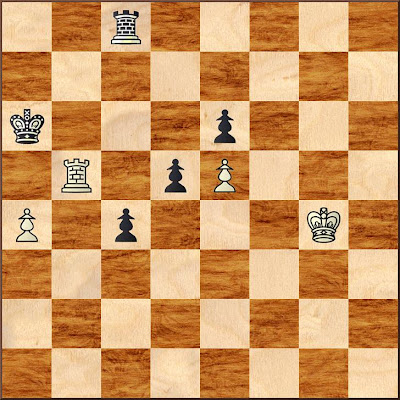These two games were played at correspondence time controls. The first started two weeks ago and ended this morning. The second was played a bit over six years ago.
Internet Opponent (1734) -- Stripes,James (2020) [C02]
chess.com championships - Round 3 Chess.com, 26.02.2013
1.e4 e6 2.d4 d5 3.e5 c5 4.c3 Nc6 5.f4
5.Nf3 is considered best
5...Qb6 6.Nf3 Bd7 7.Be2
One way to protect the d-pawn involves moving more pawns: 7.a3 Nh6 8.b4 cxd4 9.cxd4 Nf5 10.Bb2.
Nh6
7...Nge7 is another route to f5. I have played both. In six games from the position after 7.Be2, I have five wins with Black and one loss. In that loss, I played Ne7-f5 prematurely, permitting the g-pawn to drive the knight back. In the other five, I won the d-pawn easily. Most of these games were online blitz.
White to move
8.h3 cxd4 9.cxd4 Nf5 10.a3 Ncxd4 11.Nxd4
Black to move
11...Qxd4
11...Nxd4 is stronger, but I was playing for an easy endgame.
12.Qxd4 Nxd4 13.Bd1 Rc8 14.Be3 Nc2+ 15.Bxc2 Rxc2 16.0–0 b6 17.b4 Be7 18.Rc1 Rxc1+ 19.Bxc1 0–0 20.Bb2
Black to move
20...f6
It seemed important to give my bishops some mobility through pawn exchanges.
21.exf6 Bxf6
And then I opted to get more pieces off the board, trusting that my center pawn majority would rule.
22.Bxf6 gxf6 23.Nd2 Kf7 24.Rc1 Rc8 25.Rxc8 Bxc8 26.Kf2
Black to move
26...Ba6
26...e5 seems better in retrospect.
27.a4 Bd3 28.g4 Kg6 29.Ke3 Bc2 30.a5 h5 31.Nf3 hxg4 32.hxg4 Bd1
White to move
33.Kf2
33.Nd4 retains a small chance. The pawn ending is too easy for Black.
33...Bxf3 34.Kxf3 e5 35.fxe5 fxe5 36.axb6 axb6 37.b5 Kg5 38.Kg3 e4 0–1
My opponent on GameKnot made the same opening error, but followed it with more vigorous play.
Internet Opponent (1641) -- Stripes,James (1782) [C02]
Team match http://gameknot.com, 27.09.2006
1.e4 e6 2.d4 d5 3.e5 c5 4.c3 Nc6 5.f4 Bd7 6.Nf3 Qb6 7.Be2 Nh6 8.0–0 cxd4 9.cxd4 Nf5 10.Bd3
Moving this bishop a second time does not seem unreasonable.
Black to move
10...Ncxd4 11.Nxd4 Qxd4+ 12.Kh1 Ne3 13.Bxe3 Qxe3 14.Nc3 Bc6 15.Bb5 Qb6 16.Bxc6+ bxc6 17.Qc2 Rb8 18.b3 Be7 19.Na4 Qb5 20.Rac1 Rc8 21.Nc5 Bxc5 22.Qxc5 Qxc5 23.Rxc5 Kd7
I made several inaccuracies getting to this position, but retain a clear advantage.
White to move
24.Rfc1 h5
After the game, my opponent praised my h-pawn thrust.
25.Kg1 h4 26.Kf2 Rh5 27.Ra5 Rc7 28.b4
Black to move
28...g5 29.g4 hxg3+
The en passant capture.
30.hxg3 gxf4 31.gxf4 Rh2+ 32.Kg3 Rb2 33.a3 Kc8 34.Rac5 Kb7 35.R1c3 Rc8 36.Kf3 Rh2 37.a4
Black still had some work to do before this error.
Black to move
37...Rh3+ 38.Kg4 Rxc3 39.Rxc3 a5 40.Rb3 Ka6
Following a strong move with a weak move. Sometimes easy endings prove difficult when they invite carelessness.
41.f5
41.b5 gives Black more trouble.
41...axb4 42.Rxb4 c5 43.Rb5 c4 44.fxe6 fxe6
Although still only down one pawn, White's few remaining hopes have disappeared.
White to move
45.Rb1 Ka5 46.Kg5 Rf8 47.Rb7 Kxa4 48.Kg6 Rf5 49.Re7 Rxe5 50.Kf6 Re4 51.Rc7 Kb3 52.Rb7+ Kc2 53.Rc7 c3 54.Ke7 Kd2 55.Kd6 c2 0–1
Was 5.f4 the decisive error, or did it come a few moves later? I have faced 5.f4 once in over the board play. That, too, was an easy win for Black.
























No comments:
Post a Comment